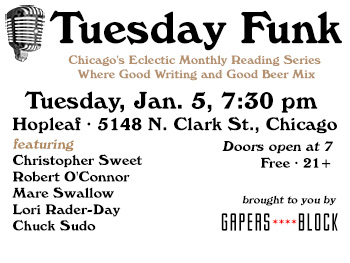| « Book Review: 8-Bit Christmas by Kevin Jakubowski | Twelve Fascinating Facts about Chicago from the 2014 World Almanac » |
Books Mon Dec 23 2013
Housing History Repeats Itself in Lawrence J. Vale's Purging the Poorest
 I've been paying closer attention, lately, to the tail end of my morning commute: west along North Avenue from the lake to Larabee, then south. Of course, I'd always noticed the yellow-brick row houses of the Cabrini homes hunched across from my office building, behind the luxury condos and parking garages--fewer than 150 of them occupied, since the Chicago Housing Authority cleared hundreds of the units with an as-yet-unfulfilled promise that residents would return to a full-scale renovation. And although it's not on my way, the former site of the William Green Homes' last towers still shocks me with its emptiness when I happen to pass by. Lately, if I approach from the east past the shiny new Target, it even takes a moment for me to remember what that land was emptied of.
I've been paying closer attention, lately, to the tail end of my morning commute: west along North Avenue from the lake to Larabee, then south. Of course, I'd always noticed the yellow-brick row houses of the Cabrini homes hunched across from my office building, behind the luxury condos and parking garages--fewer than 150 of them occupied, since the Chicago Housing Authority cleared hundreds of the units with an as-yet-unfulfilled promise that residents would return to a full-scale renovation. And although it's not on my way, the former site of the William Green Homes' last towers still shocks me with its emptiness when I happen to pass by. Lately, if I approach from the east past the shiny new Target, it even takes a moment for me to remember what that land was emptied of.
But thanks to Lawrence J. Vale's Purging the Poorest: Public Housing and the Design Politics of Twice-Cleared Communities, these days I've been looking not just at the negative space of the former Cabrini-Green area; I've also been paying attention to what, and who, has filled in the blanks. There's a strange feel to these mostly market-rate developments, swept clean of the obvious history that permeates the built environment of the other central neighborhoods. There are not a lot of public spaces and not a lot of people on the residential streets, just stretches of new brick and still-raw-looking landscaping occasionally punctuated by the profounder silence of a grass or gravel lot. The facades seem almost part of a set, unobtrusive scenery to sail past as our main characters take a drive downtown.
An observer feeling uncharitable to the CHA and HUD (whose HOPE VI program spurred the move toward demolition and mixed-income redevelopment) might say that that's just what these buildings are: something pleasant to look at on the upper class's way into the Gold Coast. Certainly, they're more attractive than the embattled monoliths of Cabrini or, before them, the lowland slum known as Little Hell. As Vale makes clear from the subtitle of his book onward, housing design is unavoidably political, and its intended beneficiaries are often those who have to look at the results as much as those who actually live there. In Atlanta, the other city he plucks a representative case from, the mixed-race Tech Flats area was first framed as an eyesore to executives at the nearby Coca Cola plant and the all-white student body of Georgia Tech--and then, after the Techwood/Howell project had itself deteriorated by the early 1990s, as an embarrassment before the millions of international eyes that would be on Atlanta during the 1996 Olympics.
 Vale makes a compelling case that history has repeated itself in the razing of America's mid-20th-century projects, which he argues stemmed from largely the same motives that inspired the building of those projects in the first place. This may seem contradictory, unless you view both efforts as primarily motivated by the need for clearance, and not by the need to house inhabitants from the areas being cleared.
Vale makes a compelling case that history has repeated itself in the razing of America's mid-20th-century projects, which he argues stemmed from largely the same motives that inspired the building of those projects in the first place. This may seem contradictory, unless you view both efforts as primarily motivated by the need for clearance, and not by the need to house inhabitants from the areas being cleared.
When the Cabrini and Techwood homes were first proposed, in the 1930s and '40s, civic leaders called for the demolition of substandard housing and for the construction of healthful, high-quality housing for the poor. The question of which poor was routinely elided, perhaps counting on the natural assumption the distressed areas' current residents would be offered places in the new housing. But the concept of the "deserving poor" (as opposed to those who, through surmised flaws in character, deserve to be poor) has been ever with us, and housing agencies in both cities from patrolled its boundaries from the start through exhaustive tenant screening, rather high income guidelines, and, at first, strict racial quotas. (Techwood, when built, was all white; Cabrini was permitted only 20% black households.) Vanishingly few of the demolished neighborhoods' residents ever returned to their homes' supposed replacements.
Likewise, there are public-housing tenants in the privately owned, mixed-income developments that have replaced Cabrini and Techwood--but not all that many and not nearly as many as the two cities' housing authorities often led the people its demolitions were displacing to believe there would be. Selection criteria for the new developments were relatively strict, but there's also an inherent problem in clearing housing for same-site redevelopment: you have to put its residents somewhere while you wait for the new buildings to go up. Accordingly, they're often dispersed to farther-flung areas with similar concentrations of poverty and violence.
Another factor in the very lopsided mix that predominates in today's mixed-income developments: HUD dropped the requirement for one-for-one replacement of public-housing units in the mid-1990s, leading developers naturally to plan for the minimum required number of subsidized units in new construction. One thread of rhetoric running through the drive for mixed-income communities has been the need to supply poor families with middle-class neighbors as role models, but apparently the role models must never be made to feel the presence of those their proximity is supposed to be improving. Early plans for Chicago developments such as Parkside of Old Town lumped the required public-housing units together in the lower floors of the midrise buildings, until the Cabrini-Green Local Advisory Council pushed for a "finer-grained mix."
If accommodating even this upper tier of the poor is burdensome, what of the people who will never make it back into the well-placed Chicago and Atlanta neighborhoods they once called home? The response from housing authorities has been, basically: not our problem. A DNAinfo Chicago article from earlier this year on a lawsuit brought by the remaining tenants of the mostly-boarded-up Cabrini Homes recorded reports of former residents stuck on the South and West Sides or even pushed out of state under the pressures of rent, crime rates, and gnawing uncertainty as to whether vague promises of right of return will be fulfilled.
Vale notes that "during the Plan for Transformation, 90 percent of CHA residents who were offered a right of return initially sought to exercise that right, rather than accept the one-time offer of permanent relocation using a HCV [housing choice voucher] . . . A dozen years later, however, only 11 percent of those families have gained a spot in one of the mixed-income communities that had long been so tantalizingly touted as the Plan's policy centerpiece." In the emptied spaces of Cabrini-Green there used to stand not only crumbling skyscrapers and gang turf, but close-knit communities that grew over decades and cherished their proximity to the stuff that makes Chicago a city to show off to the world.
We could probably do better, says Vale, allowing himself the rare note of chastisement in his evenhanded and scrupulously documented account: "The alternatives are not just retention of failed practices versus wholesale community replacement." Indeed, other cities have, often by engineering narrower but still diverse mixes of income tiers in projects that continued to comprise mostly public units. ("Neighborhoods composed primarily of . . . those often labeled the 'working poor' . . . should not be confused with 'concentrations of poverty,'" notes Vale.) But we may not get the chance. Vale suspects that the cycling pattern of American cities' grand experiments with public housing are coming to an end as their ruins are absorbed back into a market-controlled landscape. Having tried to cleanse their cities of their poorest elements, governments now seem to want to wash their hands of housing for good.
To the layperson with an abiding fascination with public housing and urban planning, Purging the Poorest will be an engaging but probably still not a quick read; it is an academic text, after all. For anyone who wants to explore the book's key arguments and insights into Chicago's not-so-distant history in a faster format, Vale will appear at the Harold Washington Library, 400 S. State St., at 6pm on January 23 to discuss his work.
Photo of the William Green Homes circa 1999 from the Library of Congress Prints and Photographs Division.









